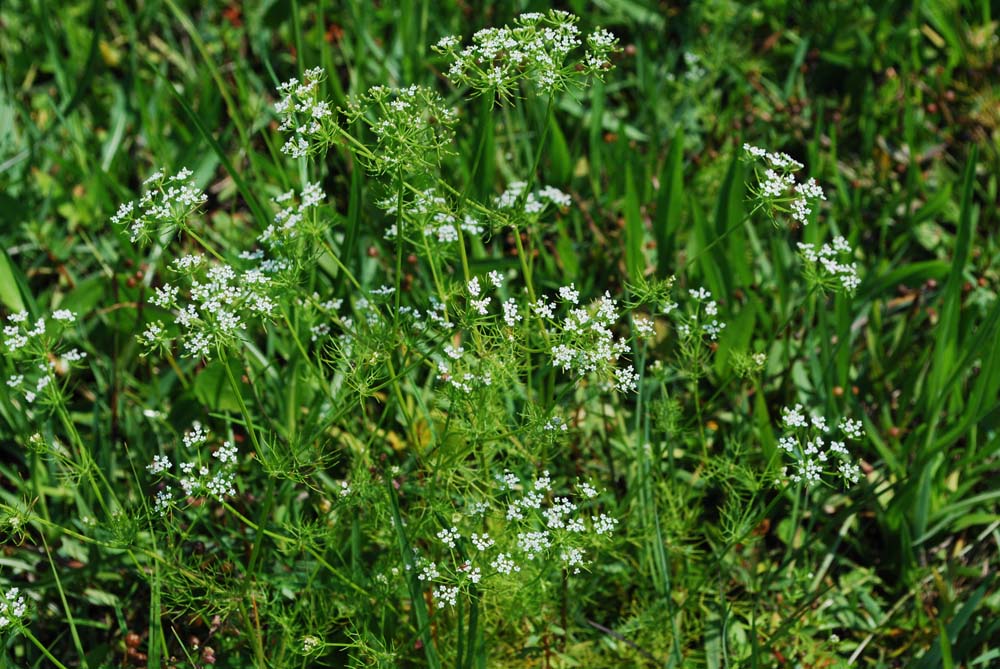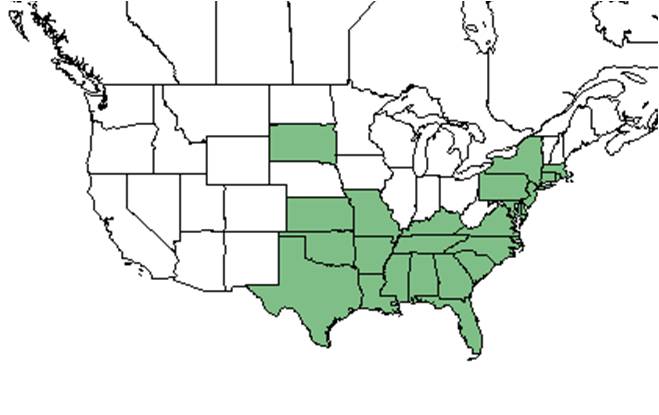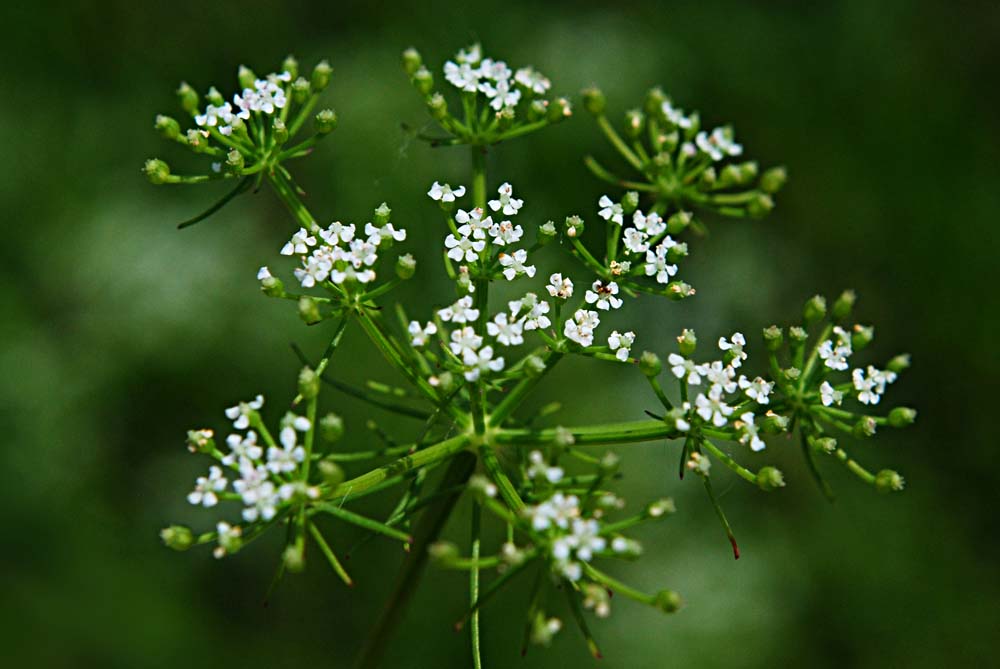Difference between revisions of "Ptilimnium capillaceum"
KatieMccoy (talk | contribs) |
HaleighJoM (talk | contribs) (→Ecology) |
||
| (31 intermediate revisions by 9 users not shown) | |||
| Line 3: | Line 3: | ||
{{taxobox | {{taxobox | ||
| name = Ptilimnium capillaceum | | name = Ptilimnium capillaceum | ||
| − | | image = | + | | image = Ptil_capi.jpg |
| − | | image_caption = | + | | image_caption = Photo by Wayne Matchett, [http://www.spacecoastwildflowers.com SpaceCoastWildflowers.com] |
| regnum = Plantae | | regnum = Plantae | ||
| divisio = Magnoliophyta - Flowering plants | | divisio = Magnoliophyta - Flowering plants | ||
| Line 18: | Line 18: | ||
}} | }} | ||
| − | Common names: Threadleaf | + | Common names: Threadleaf mock bishopweed, Herbwilliam, Eastern bishopweed |
==Taxonomic notes== | ==Taxonomic notes== | ||
| + | Synonyms: none | ||
| + | |||
==Description== | ==Description== | ||
<!-- Basic life history facts such as annual/perrenial, monoecious/dioecious, root morphology, seed type, etc. --> | <!-- Basic life history facts such as annual/perrenial, monoecious/dioecious, root morphology, seed type, etc. --> | ||
| + | Flowers are arranged in umbels.<ref name="FSU Herbarium">Florida State University Robert K. Godfrey Herbarium database. URL: [http://herbarium.bio.fsu.edu http://herbarium.bio.fsu.edu]. Last accessed: November 2015. Collectors: William P. Adams, Loran C. Anderson, Kurt E. Blum, Dave Breil, Sidney T. Brinson, G. Fleming, P. Genelle,, C.S. Gidden, R.K. Godfrey, Darren Jackson, D.E. Kennemore Jr., G. Knight, Mabel Kral, R. Kral, Robert J. Lamaire, S.W. Leonard, Sidney McDaniel, William Lindsey,W. Miley, Marc Minno, Richard Mitchell, John B. Nelson, Elmer C. Prichard, Ronald A. Pursell, Gwynn W. Ramsey, P.L. Redfearn Jr., A. Redman, Grady W. Reinert, V. Rosario, Cecil R. Slaughter, Bian Tan, D.B. Ward, S.S. Ward, Jean W. Wooten. States and Counties: Florida: Alachua, Bradford, Brevard, Calhoun, Charlotte, Citrus, Columbia, DeSoto, Dixie, Escambia, Franklin, Hamilton, Hernando, Jackson, Jefferson, Lafayette, Leon, Liberty, Madison, Nassau, Okaloosa, Orange, Polk, Putnam, St. Johns, Sumter, Suwannee, Taylor, Union, Volusia, Wakulla. Georgia: Thomas. Compiled by Tall Timbers Research Station and Land Conservancy.</ref> | ||
| + | |||
| + | "Glabrous annuals with pinnately decompound leaves or the leaves reduced to hollow, septate phyllodes. Umbels compound, terminal and axillary; involucre and involucel present; petals white. Fruit broadly ovoid to suborbicular, 1-4 mm long, glabrous, ribs prominent; mericarps semicircular in cross section."<ref name="Radford et al 1964">Radford, Albert E., Harry E. Ahles, and C. Ritchie Bell. Manual of the Vascular Flora of the Carolinas. 1964, 1968. The University of North Carolina Press. 784. Print.</ref> | ||
| + | |||
| + | "Plant 1-8 dm tall. Leaves pinnately and finely decompound into numerous filiform segments 2-5 mm or more long. Peduncles 3-8 cm long; involucral bracts foliaceous, 5 mm or more long; rays 3-20, spreading, 6-21 mm long; involucel bractlets linear, about ½ length of pedicels; styles 0.2-1.5 mm long. Fruit 1.5-3 (4) mm long, 1.5 (2) mm broad."<ref name="Radford et al 1964"/> | ||
==Distribution== | ==Distribution== | ||
| + | It is distributed from eastern and central United States west to Texas and south to Miami-Dade and Collier counties.<ref name="regional">http://regionalconservation.org/beta/nfyn/plantdetail.asp?tx=Ptilcapi. Accessed: March 1, 2016</ref> | ||
| + | |||
| + | ''Ptilimnium capillaceum'' is endemic to an area from southeastern Virginia to southeastern Georgia which is the northern end of Longleaf Pine range.<ref>Sorrie, B. A. and A. S. Weakley 2001. Coastal Plain valcular plant endemics: Phytogeographic patterns. Castanea 66: 50-82.</ref> | ||
| + | |||
==Ecology== | ==Ecology== | ||
===Habitat=== <!--Natural communities, human disturbed habitats, topography, hydrology, soils, light, fire regime requirements for removal of competition, etc.--> | ===Habitat=== <!--Natural communities, human disturbed habitats, topography, hydrology, soils, light, fire regime requirements for removal of competition, etc.--> | ||
| − | In the Coastal Plain in Florida and Georgia, ''P. capillaceum'' has occurred in wiregrass/slashpine communities; the edge of a small cattail swale; mucky soils of floodplains; dry pond in a coastal hammock; cabbage palm hammocks; scrubby flatwoods adjacent to cypress swamps; slough edges; wet ditches bordering flatwoods; borders of salt flats; wet sands near a salt marsh; gum depressions; low depressions amongst sand dunes; middle of a lake growing on a tree stump; and cypress-sweetgum floodplains. It has also been observed in disturbed areas such as roadsides, a grazed cabbage palm hammock, moist roadside ditches, along railroad beds, marsh in a drainage canal bordering a swamp forest, permanently flooded pits, drained clearing of a wet hammock, exposed peat beneath pond cypresses ringing a lake after draining, and powerline transects across pine flatwoods | + | In the Coastal Plain in Florida and Georgia, ''P. capillaceum'' has occurred in wiregrass/slashpine communities; the edge of a small cattail swale; mucky soils of floodplains; dry pond in a coastal hammock; cabbage palm hammocks; scrubby flatwoods adjacent to cypress swamps; slough edges; wet ditches bordering flatwoods; borders of salt flats; wet sands near a salt marsh; gum depressions; low depressions amongst sand dunes; middle of a lake growing on a tree stump; and cypress-sweetgum floodplains. It has also been observed in disturbed areas such as roadsides, a grazed cabbage palm hammock, moist roadside ditches, along railroad beds, marsh in a drainage canal bordering a swamp forest, permanently flooded pits, drained clearing of a wet hammock, exposed peat beneath pond cypresses ringing a lake after draining, and powerline transects across pine flatwoods. Soil types include loamy sand, sand, sandy loam, sandy peat, clay, and peaty soil. It has been observed to grow in both full sun and very shaded locations. Associated species include ''Anagallis minima, Eleocharis albida, Bacopa monnieri, Dichromena colorata'' and ''Sagittaria.''<ref name="fsu">Florida State University Robert K. Godfrey Herbarium database. URL: http://herbarium.bio.fsu.edu. Last accessed: November 2015. Collectors: William P. Adams, Loran C. Anderson, Kurt E. Blum, Dave Breil, Sidney T. Brinson, G. Fleming, P. Genelle,, C.S. Gidden, R.K. Godfrey, Darren Jackson, D.E. Kennemore Jr., G. Knight, Mabel Kral, R. Kral, Robert J. Lamaire, S.W. Leonard, Sidney McDaniel, William Lindsey,W. Miley, Marc Minno, Richard Mitchell, John B. Nelson, Elmer C. Prichard, Ronald A. Pursell, Gwynn W. Ramsey, P.L. Redfearn Jr., A. Redman, Grady W. Reinert, V. Rosario, Cecil R. Slaughter, Bian Tan, D.B. Ward, S.S. Ward, Jean W. Wooten. States and Counties: Florida: Alachua, Bradford, Brevard, Calhoun, Charlotte, Citrus, Columbia, DeSoto, Dixie, Escambia, Franklin, Hamilton, Hernando, Jackson, Jefferson, Lafayette, Leon, Liberty, Madison, Nassau, Okaloosa, Orange, Polk, Putnam, St. Johns, Sumter, Suwannee, Taylor, Union, Volusia, Wakulla. Georgia: Thomas. Compiled by Tall Timbers Research Station and Land Conservancy.</ref> |
===Phenology=== <!--Timing off flowering, fruiting, seed dispersal, and environmental triggers. Cite PanFlora website if appropriate: http://www.gilnelson.com/PanFlora/ --> | ===Phenology=== <!--Timing off flowering, fruiting, seed dispersal, and environmental triggers. Cite PanFlora website if appropriate: http://www.gilnelson.com/PanFlora/ --> | ||
| − | + | ''P. capillaceum'' has been observed to flower March through July and fruit April through July.<ref name="FSU Herbarium"/><ref>Nelson, G. [http://www.gilnelson.com/ PanFlora]: Plant data for the eastern United States with emphasis on the Southeastern Coastal Plains, Florida, and the Florida Panhandle. www.gilnelson.com/PanFlora/ Accessed: 13 DEC 2016</ref> | |
| + | <!--===Seed dispersal===--> | ||
| + | <!--===Seed bank and germination===--> | ||
| − | |||
| − | |||
===Fire ecology=== <!--Fire tolerance, fire dependence, adaptive fire responses--> | ===Fire ecology=== <!--Fire tolerance, fire dependence, adaptive fire responses--> | ||
| − | It has been observed in an annually burned boggy draw in a pine forest | + | It has been observed in an annually burned boggy draw in a pine forest.<ref name="FSU Herbarium"/> |
===Pollination=== | ===Pollination=== | ||
| − | The following | + | The following species were observed visiting flowers of ''Ptilimnium capillaceum'' at the Archbold Biological Station:<ref name="Deyrup 2015">Deyrup, M.A. and N.D. 2015. Database of observations of Hymenoptera visitations to flowers of plants on Archbold Biological Station, Florida, USA.</ref> |
| + | |||
| + | Bees from the family Apidae: ''Apis mellifera, Epeolus floridensis'' | ||
| + | |||
| + | Plasterer bees from the family Colletidae: ''Colletes mandibularis'' | ||
| − | + | Sweat bees from the family Halictidae: ''Halictus poeyi, Lasioglossum tamiamensis'' | |
| − | + | Thread-waisted bees from the family Sphecidae: ''Epinysson basilaris, E. mellipes, Hoplisoides denticulatus denticulatus, Liris argentata, L. muesebecki, Oxybelus laetus fulvipes, Tachytes intermedius, T. mergus'' | |
| − | + | Wasps from the family Vespidae: ''Euodynerus megaera, Pachodynerus erynnis, Parancistrocerus bicornis, P. fulvipes rufovestris'' | |
| − | + | ===Herbivory and toxicology===<!--Common herbivores, granivory, insect hosting, poisonous chemicals, allelopathy, etc--> | |
| + | ''P. capillaceum'' is the host species to the caterpillars of Black Swallowtail (''Papilio polyxenes'').<ref name="gobotany">[[https://gobotany.newenglandwild.org/species/ptilimnium/capillaceum/]]Go Botany. Accessed: March 2, 2016</ref> | ||
| + | <!--===Diseases and parasites===--> | ||
| − | + | ==Conservation, cultivation, and restoration== | |
| − | == | + | ==Cultural use== |
| − | |||
| − | |||
| − | |||
==Photo Gallery== | ==Photo Gallery== | ||
| + | <gallery widths=180px> | ||
| + | File: Ptil_capi_WMatchett-SpaceCoastWildflowers-042.jpg | <center> Flowers of ''Ptilimnium'' ''capillaceum'' <p> Photo by Wayne Matchett, [http://www.spacecoastwildflowers.com SpaceCoastWildflowers.com] </p> | ||
| + | </gallery> | ||
==References and notes== | ==References and notes== | ||
| − | |||
Latest revision as of 09:33, 15 July 2022
| Ptilimnium capillaceum | |
|---|---|

| |
| Photo by Wayne Matchett, SpaceCoastWildflowers.com | |
| Scientific classification | |
| Kingdom: | Plantae |
| Division: | Magnoliophyta - Flowering plants |
| Class: | Magnoliopsida – Dicotyledons |
| Order: | Apiales |
| Family: | Apiaceae |
| Genus: | Ptilimnium |
| Species: | P. capillaceum |
| Binomial name | |
| Ptilimnium capillaceum (Michx.) Raf. | |

| |
| Natural range of Ptilimnium capillaceum from USDA NRCS Plants Database. | |
Common names: Threadleaf mock bishopweed, Herbwilliam, Eastern bishopweed
Contents
Taxonomic notes
Synonyms: none
Description
Flowers are arranged in umbels.[1]
"Glabrous annuals with pinnately decompound leaves or the leaves reduced to hollow, septate phyllodes. Umbels compound, terminal and axillary; involucre and involucel present; petals white. Fruit broadly ovoid to suborbicular, 1-4 mm long, glabrous, ribs prominent; mericarps semicircular in cross section."[2]
"Plant 1-8 dm tall. Leaves pinnately and finely decompound into numerous filiform segments 2-5 mm or more long. Peduncles 3-8 cm long; involucral bracts foliaceous, 5 mm or more long; rays 3-20, spreading, 6-21 mm long; involucel bractlets linear, about ½ length of pedicels; styles 0.2-1.5 mm long. Fruit 1.5-3 (4) mm long, 1.5 (2) mm broad."[2]
Distribution
It is distributed from eastern and central United States west to Texas and south to Miami-Dade and Collier counties.[3]
Ptilimnium capillaceum is endemic to an area from southeastern Virginia to southeastern Georgia which is the northern end of Longleaf Pine range.[4]
Ecology
Habitat
In the Coastal Plain in Florida and Georgia, P. capillaceum has occurred in wiregrass/slashpine communities; the edge of a small cattail swale; mucky soils of floodplains; dry pond in a coastal hammock; cabbage palm hammocks; scrubby flatwoods adjacent to cypress swamps; slough edges; wet ditches bordering flatwoods; borders of salt flats; wet sands near a salt marsh; gum depressions; low depressions amongst sand dunes; middle of a lake growing on a tree stump; and cypress-sweetgum floodplains. It has also been observed in disturbed areas such as roadsides, a grazed cabbage palm hammock, moist roadside ditches, along railroad beds, marsh in a drainage canal bordering a swamp forest, permanently flooded pits, drained clearing of a wet hammock, exposed peat beneath pond cypresses ringing a lake after draining, and powerline transects across pine flatwoods. Soil types include loamy sand, sand, sandy loam, sandy peat, clay, and peaty soil. It has been observed to grow in both full sun and very shaded locations. Associated species include Anagallis minima, Eleocharis albida, Bacopa monnieri, Dichromena colorata and Sagittaria.[5]
Phenology
P. capillaceum has been observed to flower March through July and fruit April through July.[1][6]
Fire ecology
It has been observed in an annually burned boggy draw in a pine forest.[1]
Pollination
The following species were observed visiting flowers of Ptilimnium capillaceum at the Archbold Biological Station:[7]
Bees from the family Apidae: Apis mellifera, Epeolus floridensis
Plasterer bees from the family Colletidae: Colletes mandibularis
Sweat bees from the family Halictidae: Halictus poeyi, Lasioglossum tamiamensis
Thread-waisted bees from the family Sphecidae: Epinysson basilaris, E. mellipes, Hoplisoides denticulatus denticulatus, Liris argentata, L. muesebecki, Oxybelus laetus fulvipes, Tachytes intermedius, T. mergus
Wasps from the family Vespidae: Euodynerus megaera, Pachodynerus erynnis, Parancistrocerus bicornis, P. fulvipes rufovestris
Herbivory and toxicology
P. capillaceum is the host species to the caterpillars of Black Swallowtail (Papilio polyxenes).[8]
Conservation, cultivation, and restoration
Cultural use
Photo Gallery
Flowers of Ptilimnium capillaceum Photo by Wayne Matchett, SpaceCoastWildflowers.com
References and notes
- ↑ 1.0 1.1 1.2 Florida State University Robert K. Godfrey Herbarium database. URL: http://herbarium.bio.fsu.edu. Last accessed: November 2015. Collectors: William P. Adams, Loran C. Anderson, Kurt E. Blum, Dave Breil, Sidney T. Brinson, G. Fleming, P. Genelle,, C.S. Gidden, R.K. Godfrey, Darren Jackson, D.E. Kennemore Jr., G. Knight, Mabel Kral, R. Kral, Robert J. Lamaire, S.W. Leonard, Sidney McDaniel, William Lindsey,W. Miley, Marc Minno, Richard Mitchell, John B. Nelson, Elmer C. Prichard, Ronald A. Pursell, Gwynn W. Ramsey, P.L. Redfearn Jr., A. Redman, Grady W. Reinert, V. Rosario, Cecil R. Slaughter, Bian Tan, D.B. Ward, S.S. Ward, Jean W. Wooten. States and Counties: Florida: Alachua, Bradford, Brevard, Calhoun, Charlotte, Citrus, Columbia, DeSoto, Dixie, Escambia, Franklin, Hamilton, Hernando, Jackson, Jefferson, Lafayette, Leon, Liberty, Madison, Nassau, Okaloosa, Orange, Polk, Putnam, St. Johns, Sumter, Suwannee, Taylor, Union, Volusia, Wakulla. Georgia: Thomas. Compiled by Tall Timbers Research Station and Land Conservancy.
- ↑ 2.0 2.1 Radford, Albert E., Harry E. Ahles, and C. Ritchie Bell. Manual of the Vascular Flora of the Carolinas. 1964, 1968. The University of North Carolina Press. 784. Print.
- ↑ http://regionalconservation.org/beta/nfyn/plantdetail.asp?tx=Ptilcapi. Accessed: March 1, 2016
- ↑ Sorrie, B. A. and A. S. Weakley 2001. Coastal Plain valcular plant endemics: Phytogeographic patterns. Castanea 66: 50-82.
- ↑ Florida State University Robert K. Godfrey Herbarium database. URL: http://herbarium.bio.fsu.edu. Last accessed: November 2015. Collectors: William P. Adams, Loran C. Anderson, Kurt E. Blum, Dave Breil, Sidney T. Brinson, G. Fleming, P. Genelle,, C.S. Gidden, R.K. Godfrey, Darren Jackson, D.E. Kennemore Jr., G. Knight, Mabel Kral, R. Kral, Robert J. Lamaire, S.W. Leonard, Sidney McDaniel, William Lindsey,W. Miley, Marc Minno, Richard Mitchell, John B. Nelson, Elmer C. Prichard, Ronald A. Pursell, Gwynn W. Ramsey, P.L. Redfearn Jr., A. Redman, Grady W. Reinert, V. Rosario, Cecil R. Slaughter, Bian Tan, D.B. Ward, S.S. Ward, Jean W. Wooten. States and Counties: Florida: Alachua, Bradford, Brevard, Calhoun, Charlotte, Citrus, Columbia, DeSoto, Dixie, Escambia, Franklin, Hamilton, Hernando, Jackson, Jefferson, Lafayette, Leon, Liberty, Madison, Nassau, Okaloosa, Orange, Polk, Putnam, St. Johns, Sumter, Suwannee, Taylor, Union, Volusia, Wakulla. Georgia: Thomas. Compiled by Tall Timbers Research Station and Land Conservancy.
- ↑ Nelson, G. PanFlora: Plant data for the eastern United States with emphasis on the Southeastern Coastal Plains, Florida, and the Florida Panhandle. www.gilnelson.com/PanFlora/ Accessed: 13 DEC 2016
- ↑ Deyrup, M.A. and N.D. 2015. Database of observations of Hymenoptera visitations to flowers of plants on Archbold Biological Station, Florida, USA.
- ↑ [[1]]Go Botany. Accessed: March 2, 2016
